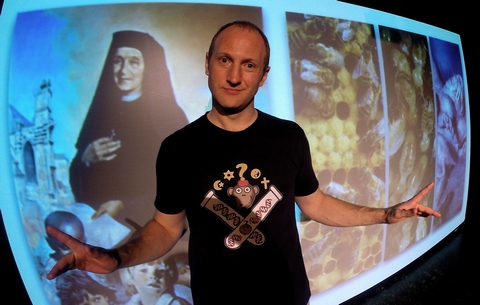Rap Guide to Religion
An entertaining and informative look at the positive and negative roles played in our culture by religion and religious belief, featuring freestyle rapping.

Baba Brinkman in a scene from “Rap Guide to Religion” at the SoHo Playhouse (Photo credit: Rudy Miller)
[avatar user=”Eric Grunin” size=”96″ align=”left”] Eric Grunin, Critic[/avatar] Performer-scholar Baba Brinkman has done a series of shows which follow the same basic format, essentially a lecture with rap interludes. A recent example seen at the SoHo Playhouse was his Rap Guide to Evolution, in which he posited that if we wanted the welfare of the human race to improve, our watch cry needs to be “don’t sleep with mean people.” At the end he gave out buttons with this phrase (I still have mine). His current show is the very entertaining (and informative) Rap Guide to Religion.
Though Brinkman admits to being a non-believer, he’s not here to disprove religion but explain it; and he’s is wise enough to insist that people of faith would not cling to their beliefs unless it benefitted their psychological and/or physical well-being.
This is important. There is a tendency among atheists to view believers with contempt, as if the faithful are merely foolish, but this attitude is unscientific and unproductive. Belief systems arise in response to real-world challenges, and those that survive do so because their adherents benefit in real-world terms. So this presentation walks (and raps) through such topics as why people create religions, why they persist in belief in the face of contradictory evidence, and ultimately what they gain. For example, when performers accept awarda they thank God for being favored, but does that mean that God actively disfavored the losers? When a natural disaster spares a handful of survivors, they thank their God, but why don’t they condemn their God for the many who died?
Brinkman doesn’t assume the audience has any special knowledge of comparative religion, and it can be enjoyed by believers and unbelievers alike. It can also be recommended to those with some background in the subject, as Brinkman’s reading in the subject is wide and up-to-date. Particularly striking, for example, was the “suffering index”: on a state by state basis, the worse off the population (in terms of quantifiable measures such as infant mortality and crime), the more religious it is.
This is also true of whole countries as well. The more people fear the future, the more they embrace religion.
So what do people get out of religion? From an evolutionary standpoint, it seems to increase survivability. Certainly many religions encourage their followers to be fruitful and multiply, and this is often carried out to the point where their neighbors start to worry. Brinkman compares the role of Catholic nuns to that of certain castes of bees, who while not fecund themselves take on child-care responsibilities so the rest of the hive can generate offspring more intensively.
He gets personal about this, tracking the lineage of his ancestor Andrew Murray. This Scottish forebear immigrated to South Africa in the early 1800’s, there to preach the gospel. The aforesaid mandate to reproduce was duly taken up, and now that one man has five thousand living descendants, including Brinkman of course.
He does talk a bit about the deep history of religion, such as the move over the last few millennia from the pan- or polytheistic belief systems to the monotheistic Abrahamic.
If you’re still reading this, the show is definitely for you. It’s not much of a ‘theater’ experience, really it’s an extended TED talk, and this brings me to my one reservation.
The TED approach is to present a maximum of clearly presented information in a minimum of time. This is fine for a ten or twenty minute lecture, but The Rap Guide to Religion is ninety minutes long, and even for someone like myself with a good attention span and a deep interest in the subject it’s too much all at once. Brinkman tries to solve this problem, as usual, by adding raps on various subject areas, but the raps are not really good enough. The refrains aren’t particularly pointed or catchy (except for “We don’t have to hurry / Andrew Murray”), and the verses are sometimes clever but more often dull. As a result, they fail to provide the relief that we need as respite between the big ideas of the main lecture. He certainly has the brains and the talent to improve them, it’s more likely he just needs to spend the time.
Rap Guide to Religion (through May 3, 2015)
SoHo Playhouse, 15 Vandam Street, in Manhattan
For tickets, call 212-691-1555 or visit http://www.SohoPlayhouse.com
Running time: One hour and 30 minutes, with no intermission






Leave a comment